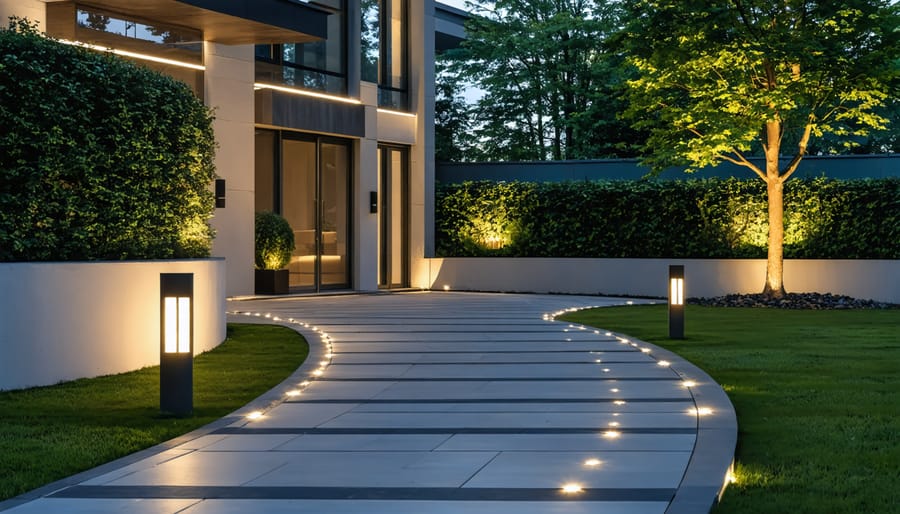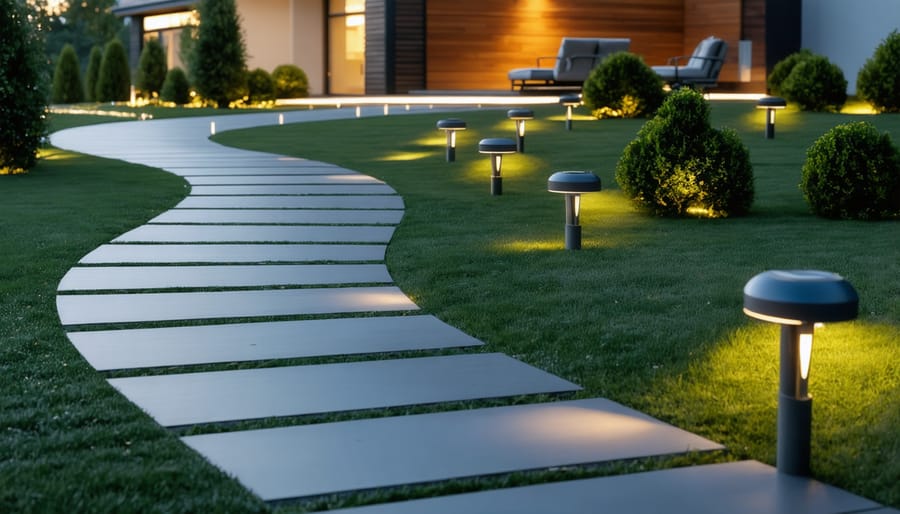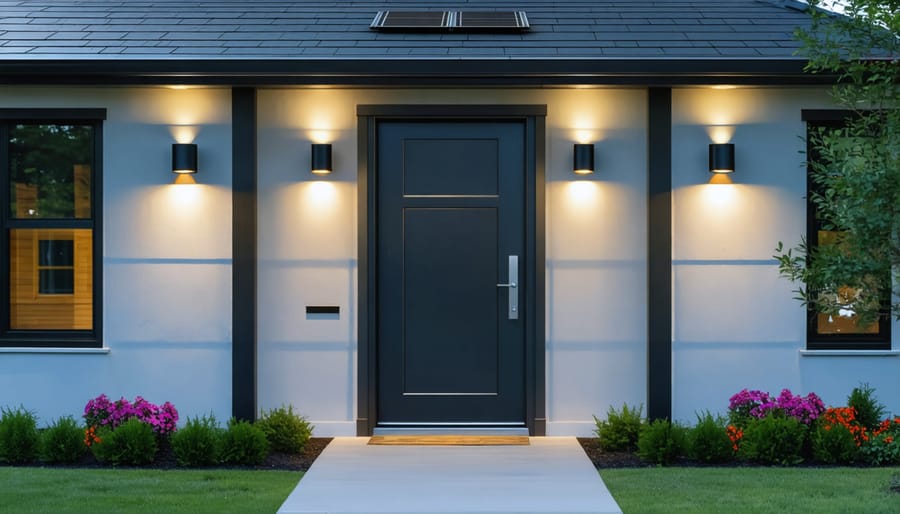Transform Your Home’s Entrance with Smart Solar Lighting That Saves Energy

Transform your home’s curb appeal with strategic solar outdoor lighting ideas that blend sustainability with sophisticated design. Position path lights at 2-meter intervals along walkways to create inviting illuminated corridors while maximizing energy efficiency. Mount motion-activated security lights at entry points and corners to enhance safety without compromising your home’s architectural features. Layer different lighting elements—combine ground-level spotlights to highlight landscaping features with decorative wall sconces that cast gentle washes of light across your façade. Install solar-powered address numbers and post lights to ensure visibility while reducing energy consumption by up to 90% compared to traditional outdoor lighting systems.
Choose fixtures with high-capacity lithium-ion batteries and monocrystalline panels to ensure reliable performance during Europe’s varying seasonal daylight hours. Smart integration of these solar solutions not only enhances your property’s nighttime presence but also contributes to the EU’s renewable energy targets while potentially increasing property value by up to 7% through improved exterior aesthetics and security features.
Essential Solar Lighting Options for Your Home’s Entrance
Path and Walkway Lighting Solutions
Strategic placement of outdoor pathway lighting creates both a welcoming atmosphere and ensures safe navigation around your property after dark. Solar path lights should be positioned approximately 1.5 to 2 metres apart along walkways, creating a balanced illumination pattern without overwhelming dark spots or excessive brightness.
For optimal performance, install lights where they receive direct sunlight during peak hours, typically facing south in European locations. Consider using stepped placement on sloped pathways, with lights slightly angled to effectively illuminate the walking surface. Modern solar path lights often feature motion sensors and adjustable brightness settings, allowing for enhanced energy efficiency while maintaining security.
When selecting path lights, opt for weather-resistant models with high-quality solar panels and LED bulbs rated for at least 5,000 hours of operation. Stake-mounted designs work well in soil borders, while surface-mounted options are ideal for paved areas. For cohesive aesthetics, choose fixtures that complement your home’s architectural style while providing sufficient illumination for safety and navigation.
Remember to keep surrounding vegetation trimmed to prevent shadows from compromising solar charging efficiency. This maintenance ensures consistent performance throughout all seasons.

Statement Entrance Lighting
Statement entrance lighting creates a welcoming atmosphere while enhancing your home’s security and kerb appeal. Solar post lights, strategically placed along pathways or at your driveway entrance, serve as elegant boundary markers whilst providing reliable illumination. These fixtures harness sunlight during the day and automatically activate at dusk, requiring no complex wiring or energy costs.
Wall-mounted solar fixtures offer a sophisticated solution for highlighting architectural features and ensuring safe navigation around your property. Consider installing pairs of matching fixtures on either side of your garage or main entrance for a symmetrical, polished look. Modern designs feature motion sensors and adjustable brightness settings, allowing you to customize the lighting to your needs.
Door frame lighting adds a touch of refinement to your entrance area. Solar-powered LED strips can be discreetly installed around door frames, creating a subtle glow that outlines your entrance. This lighting style not only enhances visibility but also adds a contemporary design element to your home’s facade. Many current models include smart features, allowing you to control timing and intensity via smartphone applications, perfectly aligning with modern European home automation trends.

Accent and Feature Lighting
Solar spotlights offer dramatic ways to highlight architectural features, sculptures, or statement plants while consuming zero grid energy. Position these versatile fixtures to cast focused beams on columns, doorways, or your home’s distinctive elements for impressive night-time dimensionality. For more subtle enhancement, consider installing solar-powered accent strips along pathways or steps, creating both visual interest and improved safety. These innovative garden lighting solutions can include colour-changing LED options, allowing you to adapt your home’s ambiance for different seasons or occasions. Decorative solar lanterns and wall sconces add personality while maintaining energy efficiency, especially when strategically placed near entranceways or seating areas. Choose fixtures with high-quality photovoltaic cells and efficient LED bulbs to ensure reliable performance throughout European winters.
Smart Integration and Control Systems
Modern solar outdoor lighting has evolved far beyond simple on/off functionality, offering sophisticated control systems that enhance both convenience and energy efficiency. Today’s smart solar lighting solutions seamlessly integrate with home automation systems, allowing homeowners to manage their outdoor illumination through smartphone apps or voice commands.
Many contemporary solar lights feature motion sensors that automatically adjust brightness based on movement detection, ensuring optimal illumination when needed while conserving energy during quiet periods. These intelligent systems can be programmed to create different lighting scenes for various occasions, from subtle everyday illumination to festive arrangements for special events.
Wireless connectivity enables remote monitoring and control of your outdoor lighting system. Through dedicated apps, you can check battery levels, adjust brightness settings, and even receive maintenance notifications. Some advanced systems incorporate weather monitoring capabilities, automatically adjusting light output based on available sunlight and forecasted weather conditions.
Scheduling features allow you to customise lighting patterns throughout the evening. For instance, you might prefer brighter illumination during early evening hours when you’re more likely to be outside, transitioning to softer, security-focused lighting later at night. Many systems also offer geofencing capabilities, automatically activating lights as you approach your home.
For enhanced security, smart solar lights can be integrated with home surveillance systems, creating coordinated responses to movement detection. Some systems even feature colour-changing capabilities, allowing you to adjust the ambiance of your outdoor space or create subtle wayfinding paths.
When selecting a smart solar lighting system, consider compatibility with existing home automation platforms and the level of control you desire. While more advanced features may require a larger initial investment, the long-term benefits of improved efficiency and convenience often justify the cost, particularly in regions with variable daylight hours.
Installation and Positioning Tips
Sun Exposure Considerations
Proper positioning of your solar outdoor lights is crucial for optimal performance. For maximum efficiency, ensure the solar panels receive at least 6-8 hours of direct sunlight daily. South-facing installations typically yield the best results in European locations, as they capture the sun’s path throughout the day. Avoid placing solar lights in heavily shaded areas, such as under dense tree canopies or close to building overhangs.
Consider seasonal variations when positioning your lights. The sun’s path changes throughout the year, so what works perfectly in summer might need adjustment for winter performance. During installation, observe your garden’s shade patterns throughout the day to identify optimal spots. Remember that even partial shade can significantly reduce charging efficiency.
For areas with limited direct sunlight, opt for solar lights with larger panels or supplementary panels that can be positioned separately from the light fixture. Some modern solar lights feature adjustable panels, allowing you to fine-tune their angle for maximum sun exposure while maintaining the desired lighting position.
If your front garden has varying light conditions, consider using a mix of standard and high-capacity solar lights to ensure consistent illumination throughout the space.

Weather-Smart Installation
For optimal performance in European climates, proper installation of solar outdoor lighting requires careful consideration of weather patterns and seasonal variations. Position solar panels to face south whenever possible, ensuring they receive maximum sunlight during shorter winter days. In regions with frequent rainfall, such as the UK or Netherlands, mount lights at least 30cm above ground level to prevent water accumulation and potential damage.
Consider local wind patterns when securing fixtures. Use marine-grade stainless steel mounting hardware in coastal areas to resist salt corrosion, and reinforce installations in regions prone to strong winds. For areas experiencing heavy snowfall, install lights with a slight tilt to prevent snow accumulation on solar panels and ensure proper drainage.
Temperature fluctuations can affect battery performance, so choose fixtures with weather-rated casings that protect internal components. In Nordic countries, opt for lithium batteries rated for cold weather operation. Install weatherproof cable housing for any wired connections between solar panels and lights, ensuring all junction points are properly sealed.
For optimal year-round performance, position motion sensors away from areas where falling leaves or snow might trigger false activations. Include drainage holes in any ground-mounted fixtures, and ensure all electrical components maintain an IP65 rating or higher for comprehensive weather protection.
Maintenance and Long-Term Performance
Seasonal Care Tips
To maintain optimal performance of your solar outdoor lighting throughout the year, seasonal care is essential. During spring, clean solar panels thoroughly to remove pollen and winter residue, and trim any overhanging vegetation that might block sunlight. Check for water damage and ensure all fixtures are securely mounted after winter storms.
Summer maintenance is relatively straightforward, but regular dusting of solar panels is crucial to maximise light absorption during peak sunlight hours. Position adjustable lights to account for longer daylight hours, and verify that ventilation slots aren’t blocked by debris or insects.
Autumn requires more frequent cleaning as falling leaves can obstruct solar panels. Adjust timing settings to accommodate shorter days, and consider repositioning lights to maintain optimal illumination patterns. Check that drainage channels around ground-mounted lights remain clear of leaves.
Winter demands the most attention. Clear snow and ice promptly from solar panels, and ensure fixtures aren’t damaged by freeze-thaw cycles. Consider using winter-specific settings that conserve battery life during shorter daylight periods. Check weatherproofing seals and tighten any loosened fixtures affected by frost heave.
For all seasons, regularly test motion sensors and clean lens covers to maintain illumination efficiency. Replace batteries in hybrid systems before winter to ensure reliable performance during darker months.
Battery Life and Replacement
Most modern solar outdoor lights use rechargeable lithium-ion batteries that typically last between 3-5 years with proper maintenance. These batteries charge during daylight hours and provide illumination for 8-12 hours, depending on the season and local weather conditions.
To maximise battery life, regularly clean the solar panels to ensure optimal charging efficiency. In European climates, where winter months bring reduced sunlight, it’s particularly important to maintain clean panels for maximum energy absorption. Consider adjusting light settings during darker months to conserve battery power.
Signs that batteries need replacement include decreased runtime, inconsistent lighting performance, or lights failing to illuminate despite adequate sun exposure. When replacing batteries, always match the voltage and capacity specifications of the original battery. Many quality solar lights feature easily accessible battery compartments for straightforward replacement.
For sustainable disposal, take old batteries to local recycling centres that handle electronic waste. Many European municipalities offer specific collection points for battery recycling, adhering to EU waste management directives. Keep replacement records to track battery performance and establish a predictable maintenance schedule, ensuring your outdoor lighting remains reliable throughout the year.
Solar outdoor lighting represents a smart, sustainable choice for enhancing your home’s exterior while contributing to a greener future. By implementing these lighting solutions, you’re not only creating an inviting and secure entrance but also reducing your carbon footprint and energy costs. The versatility of solar-powered options, from path lights to wall-mounted fixtures, ensures that every homeowner can find the perfect combination to suit their aesthetic preferences and practical needs.
The investment in solar outdoor lighting pays dividends through eliminated electricity bills and minimal maintenance requirements. As European communities increasingly embrace sustainable living practices, solar lighting stands as a testament to our commitment to environmental stewardship. The technology continues to improve, offering better efficiency and longer-lasting illumination that rivals traditional electrical systems.
Remember that successful outdoor lighting is about creating layers of light that work together harmoniously. By combining different types of solar fixtures – security lights, decorative accents, and pathway illumination – you can achieve both functionality and beauty while remaining true to eco-friendly principles.
As we move towards a more sustainable future, choosing solar-powered outdoor lighting isn’t just about enhancing your home’s curb appeal – it’s about making a conscious decision to support renewable energy solutions. Take the first step towards a brighter, more sustainable home entrance by incorporating these solar lighting ideas into your outdoor space.
Leave a Reply